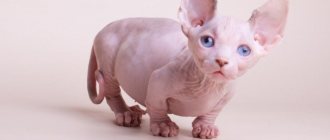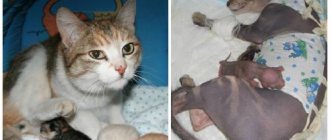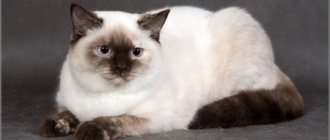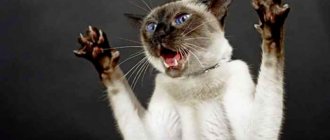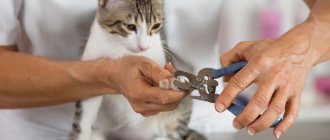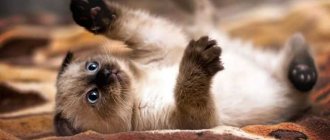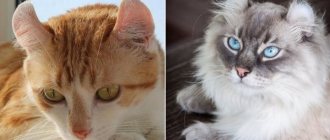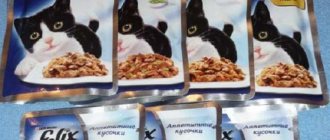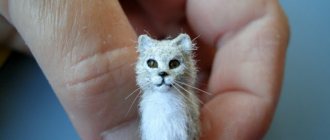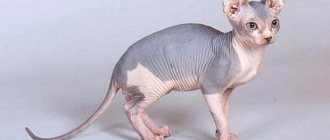The dream of many children is to have their own pet, and often a cat. Cats often serve an important role for children: they provide constant contact, keep secrets, and listen. The purring is soothing, and watching the animal play is a pleasure.
In preschool age, children learn better how to carefully and properly handle pets. At this age, children can help care for the cat under the supervision of their parents. However, of course, we must not forget that each animal has its own character, likes and dislikes. Consider below which cat breeds are still suitable for children.
American Curl Shorthair
"Curl" means "wrinkled" and this leads to the characteristic feature of this cat breed - its ears curled back. This feature arose as a result of a random mutation and was specially bred.
This is a family cat par excellence due to its pronounced good nature. She is gentle and forgiving towards small children. With older children she enjoys more daring games. A little wary of strangers. She enjoys cuddling with her owners, although she usually has a main reference.
The American Curl Shorthair also gets along very well with other pets, whether they are other cats or dogs. The cat is a very sociable cat who definitely doesn't want to be left alone. Despite their balanced, rather calm character, cats of this breed need a lot of exercise.
The noticeably curled ears are a trademark. Depending on the degree of inclination, they are more or less bent back. The coat is short, smooth and silky, with almost no undercoat. All colors are allowed. Females weigh up to 7 kg, males - up to 12.
Skitish fold (Scottish fold cat)
Fold cats, brought from China to Europe, were crossed with local breeds - this is how the Scottish Fold cat or Skitish Fold appeared. The animal is of medium size, strong, harmoniously built body with muscular legs.
The short coat is elastic and soft, adheres to the body and comes in a variety of colors. Solid color fur: white, cream, fawn, chocolate, cinnamon (a type of brown), lavender, black and blue. Tabby (pattern): spotted, striped, marbling. Bicolors (double color), tortoiseshell colors, and chinchillas are also characteristic of the Skitish Fold breed.
The Scotsman's eyes are round, open, set far apart, their color is in harmony with the color of his fur coat. They are light yellow, amber, emerald or blue.
The Scot's calling card is his ears, small, drooping forward and down. It is for these unusual ears that the breed got its name - Fold.
It is difficult to find a more flexible and affectionate pet. Distinguished by their friendly and calm character, cats of this breed enjoy life and get along well with all family members and other animals. Active and playful kittens become balanced and sedate as they grow older.
But the hunting instinct of this breed is poorly developed. Cats are absolutely not aggressive and cannot become rodent exterminators.
Bombay
Bombay was created in the USA in 1958. In the late 1950s, American breeders wanted a cat that had the texture and appearance of the Burmese, but also had a deep, glossy black color. This breed would resemble the Indian black leopard. To this end, a breeding program began for the Burmese and the black American Shorthair cat with light copper eyes. The resulting cat was named Bombay after the black leopard, which she actually resembles. Bombay was recognized as a "show cat" in the late 1970s. Although Bombays are still not common, they attract the attention of the public at any exhibition in which they are presented.
The Bombay impresses with its elegant appearance and shiny coat. Despite its bright appearance, this breed is not wild or arrogant; on the contrary, it is very pleasant and peaceful.
Bombay is quite intelligent and, due to his high intelligence, especially enjoys more demanding games, which should never become fast paced. Because she needs a lot of rest and a refuge in which she can retire if necessary. However, in most cases, the cat wants to be noticed by its owners, sometimes they demand this quite annoyingly.
Smart Bombay is trained to walk on a leash and is one of those jokingly called "dog cats." The cat does not require special care, but to keep its coat shiny, it should be brushed several times a week.
The most striking thing about Bombay is his black, silky coat. The build is petite but athletic. Females weigh on average 4 kg, and males - 5 kg. Black fur is dominant, but sable kittens are sometimes born, and some associations allow these kittens to be registered as Burmese. The Bombay's eye color ranges from gold to copper.
Turkish Angora
The noble Angora celebrated success as one of the oldest cat breeds of the Ottoman Empire. It was recognized as a breed back in the 15th century. Angora" is the old name of Ankara. For a long time, the Angora cat was understood as all cats with long hair, mostly white. The term is still used today outside of specialist circles and is sometimes used colloquially as a synonym for Turkish Angora.
This breed arose without human intervention. She is distinguished by her special loyalty, which is often compared to dogs. Because she follows her guardian every step of the way. Most of the time she hopes to be petted, as she needs a lot of love and pleasant sensations. The Turkish Angora is usually an easy-going personality that gets along well with everyone: with its relatives and other pets such as dogs, and, of course, with its owners.
This breed is an excellent playmate for children. Because their joy from playing practically knows no bounds and hardly diminishes with age. The cat also likes to fetch smaller toys, which regularly excites children. She attracts attention by purring and stroking her legs. If a cat feels neglected, it may become withdrawn. In addition to careful care, she also needs a lot of space to be able to live to her satisfaction. The cat has semi-long, silky fur that fits tightly to the body because it has no undercoat. The colors are white, black and red with different shades. The body is long and slender, at the same time muscular, although the cat looks fragile. Even male cats hardly exceed 4 kg.
Manx cat
The homeland of Manx cats is the Isle of Man, located in the Irish Sea. There are several opinions about how tailless cats got there: according to one version, they were brought from the Far East or from China, according to another, from Japan. The medium-sized animal differs from its fellows in the absence of a tail. True, not all representatives of the breed have lost this part of the body: among Manx there are short-tailed representatives and cats with tails of normal length.
A plush ball is what a baby Manx cat looks like. As he grows older, he increasingly takes on the appearance of a representative of the cat breed, but does not lose his roundness in outline.
The Manx's coat is short, fluffy and soft, with a rich undercoat: reminiscent of rabbit fur. The cat is also related to this animal by its method of movement - jumping.
The color of the animal's fur can be any. Large, round, slightly slanted eyes harmonize with the color of the fur. The look, intelligent and expressive, expresses love and devotion to the owner. Friendly and patient, these cats, at the same time, retained the hunting instinct. It is difficult for Manx to cope with large rodents, but mice and other small rodents should not hope for a quiet life.
Abyssinian
The Abyssinian's roots are in Southeast Asia, and they are one of the most bred cat breeds in the world. It came to Europe in the 19th century and was registered in Germany in 1933. Like many other cat breeds, the Abyssinian's survival was threatened during and after the two world wars.
No matter how many animals live in a farm that provides entertainment, the Abyssinian is very human-oriented. The Abyssinian cat looks at people with curiosity, and especially at children. A smart kitten carefully records every action. Cats love children very much, and boredom and excessive rest are out of the question.
The Abyssinian is slender and finely built, with long legs. Reaches a shoulder height of 40 and a length of 60 cm. Cats weigh from 2.5 to 4 kg, males - from 3.5 to 5 kg. The coat is short and has no pattern in purebred Abyssinians.
The short coat of the Abyssinian does not require special care. It should be brushed from time to time; cats shed in the spring. She needs a lot of attention, movement and variety.
Scottish Shorthair Scottish Straight
The second variety of the Scottish breed is the plush Scottish Straight kittens: the same as the Fold, only with erect ears. Among them, as well as among folds, there are those whose undercoat is very thick, and the guard hairs are quite short - then we see ideal plushness. If there is not very much undercoat, and the guard hair is longer, then the plushness will not be so pronounced.
MORE ABOUT THE BREED
Norwegian forest
The breed has been specially bred only since 1930, Norwegian Forest cats have no hereditary diseases and usually have good health.
However, the athlete cat is extremely active, a gifted climber, and constantly fulfills her desire to move. Throughout her life, she has enjoyed playing outdoors, even in inclement weather.
The beautiful Norwegian is not a cat that needs to be looked after from morning to night. On the contrary, it is economical in care.
The Norwegian Forest Cat is very affectionate with children and enthusiastically spends time with them. Due to its gentle nature, this cat is also suitable for families with small children, to whom it treats with great attention. Because she is straightforward, open-minded and quite tolerant.
The Norwegian Forest Cat is an imposing figure. This is due, on the one hand, to their size (shoulder height 45 cm, females weigh from 3.5 to 7 kg, males from 5 to 9.5), on the other hand, to their half-length body, which is especially thick in the area neck. It consists of a dense undercoat and a long, dense topcoat. The body is strong and athletic.
The Norwegian Forest Cat is easy to care for. She does not need constant outside employment and, as a rule, she is quite thrifty. Because the top coat repels moisture and dirt, your cat only needs to be brushed once a day. In principle, even once a week is enough.
Exotic cat
The breed was bred artificially, through the process of selection. The cat is medium-sized, compact, with a strong build.
The short, velvety coat of the quadruped has a thick undercoat and can be of different colors. Among the homogeneous tones there are white and black. The blue color has a gray tint, the red color has a beige tint. The tabby has a bright red tint on its back. Marble is complemented by shades and stripes.
The exotic's expressive eyes, large and round, radiate intelligence and devotion.
Cats of an exotic breed, quiet and affectionate, good-natured and easy-going, are ideal for home. They do not tolerate loneliness well because they experience strong affection and tenderness for their owner. They are unpretentious in care.
British Shorthair
The British Shorthair originated quite accidentally in 19th century Britain from domestic cats that once arrived on the island with the Romans, and various breeds. The thick fur looks like plush.
The British Shorthair cat is very fixated on people and absolutely demands attention - anywhere and at any time. The shy cat usually gets along well with other animals, especially if they have been socialized from an early age. Despite all its coziness, the powerfully built British Shorthair is also a good hunter who persistently pursues its prey.
The cat is stocky - this is due to thick hair, on the one hand, and a strong physique, on the other. Females weigh from 4 to 6 kg, males - from 7 to 8. Fur colors are very varied, but the ash color is especially popular among breeders and owners.
Siberian
It acquired its current appearance in Russia. It also came to Western Europe in the 80s of the 20th century. In 1998, the International Cat Federation recognized Siberian cats as a separate breed.
Children love them and can play and tinker with them for hours. At the same time, the cat never becomes aggressive and is especially attentive to small children.
Thus, the Siberian cat is a true family cat that gets along well with everyone. However, she usually has a loved one who loves her especially. Despite all the affection, the Siberian cat, like all representatives of natural breeds, is an excellent hunter with a great impulse to move.
The Siberian cat has semi-long, silky hair that comes in different colors and a fluffy tail. The body is quite large and muscular. Females weigh on average 4.5 kg, males 6 kg. The eyes are slightly slanted and come in a variety of colors, especially bright blue. Caring for a Siberian cat is similar to caring for a domestic cat. The Siberian cat needs a lot of exercise and affection.
Cornish Rex
The name of the Cornish Rex breed comes from the English county of Cornwall, rex - translated from English means wavy. The appearance of the Cornish Rex dates back to the mid-20th century. The medium-sized cat has an elegant, slender body with high, chiseled legs.
The coat of the representatives of the breed is short, delicate, dense and wavy. The waves are created by the undercoat because there are no guard hairs. The structure of the fur is similar to astrakhan fur, and feels plush to the touch. The color can be absolutely anything, from monochromatic to multi-colored.
The cat's eyes are interesting: large, oval, slightly slanted, rich in color, in harmony with the color of the coat, and surprisingly curious.
A sensitive and affectionate animal will give all its tenderness to the owner and other family members. In return he will ask for attention and affection. Cats suffer from loneliness, so you shouldn’t leave them alone for long periods of time. Cleanliness and order with such a pet are guaranteed.
Peterbald (Petersburg Sphynx)
Although hairless cats were bred primarily through Sphynx cats, they remain a very popular sight. However, they can be a boon for allergy sufferers. The Peterbald, like other representatives of this category, is a wonderful, sweet cat.
Peterbald owes its name to the Russian city of St. Petersburg. There he was first bred in 1994 from a pair of Don Sphynx and Oriental Shorthair.
Like its close relatives, the Peterbald is very attached to people. He prefers to cuddle and play with his loved one. He is also very open towards all residents in the house, including other pets, which he treats with great tolerance.
Peterbald especially appreciates children because they are as playful as he is. The Peterbald has no fur, only a little fluff. This is their most noticeable feature. The cat itself is slender and muscular, and can weigh up to 4 kg. The Peterbald does not require any grooming, but the skin must be protected from cold and sunlight.
